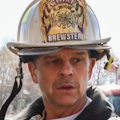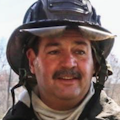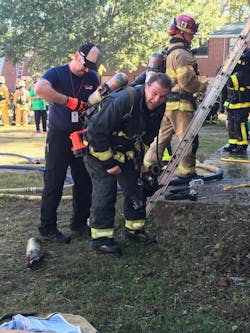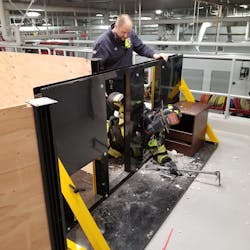You arrive on scene of a fire on the first floor of a private dwelling. The incident commander orders you and your ladder crew to search the floor above.
You exit the apparatus with your SCBA and conduct a quick, three-sided size-up. Heavy smoke can be seen coming from several second-floor windows. You move toward the front door, kneel down and don your mask. Then it hits you: It’s been several months since you touched an SCBA let alone wore one in an immediately dangerous to life and health (IDLH) atmosphere. Anxiety and hesitation begin to set in.
You and your crew proceed upstairs, where you split up to start your searches. Air begins to flow from around your mask. You ask yourself: Does my mask fit properly? Are my straps on correctly? Did I turn on the cylinder fully? What if I run out of air?
You press on. Then, your low-air alarm sounds, and your heads-up display tells you to leave the building. You begin to panic. Disorientation sets in. You’re lost and need help. On your radio, you announce, “Out of air, second floor, someone please come get me.” The next thing you know, your fellow members are placing you into an ambulance.
NFPA standards contain directives that can assist fire departments in their efforts to prevent near-miss scenarios, such as this one. These mandates (see “Why Meet the Standards” on page 58) use an all-inclusive approach to providing departments with the information and guidance to develop a respiratory protection program. Components of the NFPA standards that address fit testing, annual training requirements, SCBA safety features and air-management practices are particularly important.
Fit testing
An improperly fitted facepiece can allow hazardous products of combustion to infiltrate a firefighter’s breathing air.
A quantitative machine-based testing procedure that meets Occupational Safety and Health Administration and American National Standards Institute guidelines is mandatory for every member. Additional testing is required throughout the year should a member’s facial appearance change because of weight gain/loss, surgery, scarring or anything that prevents a proper fit. In the event that an acceptable fit can’t be achieved during the test, the department is responsible for working with the manufacturer of the facepiece to find a design that provides a satisfactory fit for the member. Departments also are mandated to provide members who wear prescription glasses with inserts that don’t interfere with the seal of the facepiece.
Because of the provisions that are noted above, many departments purchase individual facepieces for members. Doing so places the responsibility of cleaning, inspecting, and maintaining the mask and any ancillary attachments on the member.
Without question, one of the more controversial elements of the fit-testing standard relates to firefighters who have facial hair. The directive specifies that firefighters who have facial hair that interferes with the facepiece seal or operation of the SCBA aren’t permitted to use the equipment at any emergency incident or during training. Many departments neglect to enforce this fundamental safety feature of the standard. Those that fail to comply irresponsibly expose their firefighters to dangerous IDLH atmospheres, long-term health issues and potential fireground mayday scenarios. In addition, the organization is placed in a high-risk category for possible noncompliance penalties and litigation.Annual training
Knowing that the number of fires dropped significantly over the past several years, it is easy to recognize that the number of firefighters who wear an SCBA on a routine basis also decreased because of less fireground experience. (Sadly, in the time that we spent operating at emergency incidents, we witnessed firefighters wearing SCBA upside down!)
To make up for a lack of SCBA experience, to meet NFPA standards and to improve the level of safety of their members, departments are required to certify the completion of an annual SCBA training session and evaluation of each member’s competency and ability to wear the equipment. According to the NFPA, retraining is mandatory when “inadequacies in the member’s knowledge or use of the respirator indicates that the member has not retained the requisite understanding or skill” or “when any other situation occurs in which retraining appears necessary to ensure safe use.” Near-misses, urgent or mayday messages, rapid-intervention team (RIT) operations and equipment failure qualify as such situations.
To ensure that the curriculum is presented appropriately, members who present the training program should be certified to a minimum level of NFPA Fire Instructor I. All practical hands-on training requires the assignment of a safety officer.
Here’s some additional advice: Every situation on the fireground can be stressful. Operating on the interior of the structure, throwing ladders on the exterior, occupying space on the tip of the aerial or tower ladder bucket, standing by as the RIT or ventilating the building are demanding tasks that require the use of an SCBA. Departments must ensure that their members are capable of using the equipment under any of these circumstances. Incorporate the use of SCBA in all of your practical training sessions. Live by the term “Train like you play.” Your members will be more competent, better prepared and safer on the fireground.
Training essentials
To meet the numerous training requirements that are found within NFPA standards, annual SCBA training programs should include a mix of classroom and practical hands-on segments.
The classroom portion should start with a review of the department’s respiratory protection program and a hands-on, detailed examination of all of the components and safety features of the equipment, such as the regulator, harness, facepiece, gauges, heads-up display, pass alarm, end-of-service-time indicator, emergency breathing systems and universal air connections for RIT operations.
Many of us have put on SCBA that wasn’t cleaned, its straps weren’t extended, a facepiece wasn’t attached or a cylinder wasn’t full. This likely delayed the completion of fireground tasks. Annual training should include department protocols for inspecting, cleaning, storing and maintaining SCBA. It is critical to ensure that this essential life safety equipment stays in reliable working condition at all times and is available for use immediately. Never assume that the equipment that you will use is functioning properly. Check and inspect the unit each time prior to donning.
The NFPA requires SCBA training to be “conducted under simulated stressful circumstances to promote immediate response to emergency operations,” such as a loss of air, disorientation, activation of the end-of-service-time indicator, urgent or mayday events, inadequate facepiece seal and RIT operations. We highly suggest employing hands-on training sessions that challenge a firefighter’s capacity to execute responses to these events.
To make this work, a mask-confidence course that produces realistic situations that test firefighters’ skill sets and SCBA competency in vision-obscured environments using full PPE is one of the most valuable resources that departments can employ to assist them in evaluating their members’ annual proficiency and ability to operate their respiratory protection equipment under adverse conditions. In addition, a mask-confidence course allows firefighters to build their confidence and improve their ability to recognize and respond to an emergency event.
Air management
Let’s be realistic: Instances of crew staying inside of structures well past the activation of their end-of-service-time indicator occur daily. Unfortunately, our culture and tradition establish this as acceptable behavior. Take a stand. Break the habit.
Departments must take a multipronged approach, beginning with establishing written guidelines and annual training that encompass the directives that are included in the individual air management program of NFPA 1404: Standard for Fire Service Respiratory Protection Testing.
One of the more important elements of meeting the standard involves the need for firefighters to develop a “baseline” of the amount of air that they consume while conducting fire suppression operations. This is where practical-based training and mandatory use of SCBA during all hands-on training events becomes so valuable. Timing the amount of air that each individual firefighter consumes while raising a ladder, searching, stretching a line, ventilating, etc., permits personal baseline air consumption levels to be established.
Obtaining compliance with the standard and changing the culture also involves applying the practice of exiting the IDLH atmosphere before activation of the low-air alarm as well as acknowledging the fact that when the alarm does sound, the firefighter now is on the reserve air supply and potentially at risk. If this occurs, the individual and the crew are required to take immediate action based on their department’s standard operating guidelines. These might include immediately communicating emergency radio traffic, urgent or mayday messages and/or activation of the RIT.
Preparation is key
Fire departments that integrate hands-on training evolutions into the practical portion of their annual respiratory training program develop firefighters who are competent in the use of an SCBA, skilled at applying the unit’s inherent safety features, adept at recognizing and responding to SCBA emergencies and capable of confidently operating the equipment under adverse conditions. Consistent exposure to these demanding practical scenarios is without question the best approach to securing firefighter safety and preparing them for the challenges and hazards that they will confront during fireground operations. Train like you play. There is no excuse.
Why Meet the Standards?
During our careers, we have witnessed the steady transformation of SCBA as it relates to technological advancements, accessibility and use. This has been driven by the consistent periodic updating of NFPA standards, high-priority funding through the Assistance to Firefighters Grant (AFG) program, and a cultural shift among firefighters that concerns their and their crew members’ health and safety. As a result, specific subject areas and responsibilities were moved between NFPA documents, and new information was added to further categorize and clarify the purpose of each. Also, a number of new requirements in the areas of SCBA training, SCBA use during events that involve weapons of mass destruction, safety officer guidance, and facepiece inspection and use were added.
Although many members might find following NFPA standards irrelevant to the work that they do on a daily basis, it’s critical to remember that these mandates were created to prevent the recurrence of fire service tragedies.
Contained within NFPA 1500: Standard on Fire Department Occupational Safety, Health, and Wellness Program is the detailed Section 7.10 Respiratory Protection Program. Specific guidance is given to the components of the required annual training, the mandate to train and be qualified at least annually in the use of SCBA, and the directive that departments shall develop and maintain standard operating procedures that are compliant with NFPA 1500 and address the use of respiratory protection at emergency incidents.
NFPA 1852: Selection, Care, and Maintenance of Open-Circuit Self-Contained Breathing Apparatus (SCBA) ensures that firefighters use the correct SCBA for the environment in which they operate and that SCBA is properly maintained, provides the required protection and is removed from service when necessary.
NFPA 1989: Standard on Breathing Air Quality for Emergency Services Respiratory Protection defines the minimum requirements for breathing air quality, including the annual sampling and testing of same as required in the department’s respiratory protection plan.
Perhaps most notable for the purposes here is NFPA 1404: Standard for Fire Service Respiratory Protection Training. It provides specific guidance on the mandatory training components to be included within the respiratory protection program.
Back in the day, we were told that you have five minutes of air after your low-air alarm activates. We now know that statement is far from the truth. During a 2006 revision of this standard, the NFPA added one of the more influential modifications on how firefighters use SCBA: a section on the mandatory establishment of an “individual air management program.” This program includes:
- The firefighter shall exit the immediately dangerous to life and health (IDLH) atmosphere before consumption of reserve air begins
- The firefighter shall recognize that the low-air alarm notification indicates that the member is consuming the reserve air
- The firefighter and the team shall take action immediately upon activation of the low-air alarm and shall follow their department’s SOPs/SOGs
The air-management section of NFPA 1404 correlates directly to the fire service Rules of Air Management (ROAM) philosophy, which was brought to us by our friends from the Seattle Fire Department: “Know how much air you have in your SCBA and manage that air so that you leave the hazardous environment before your low-air alarm activates.” Over time, this major change in the way departments do business has proven successful.
Although not directly linked to NFPA standards, departments also must ensure that federal and state Occupational Safety and Health Administration (OSHA) regulations are included in their respiratory protection programs. OSHA’s capability to issue fines against private entities and government agencies that are found to be in violation of the agency’s directives affords the agency a formidable means of securing regulatory compliance.
A written plan that’s based on these “big four” SCBA NFPA standards is essential. Furthermore, although ultimately the responsibility for developing and employing a respiratory protection program rests with the fire chief, it is the firefighters and the officers who use the equipment who ensure that the program is followed, the equipment is used properly and the requisite training is completed on an annual basis. That said, we believe that the greatest effect lies in the standards guiding the type of training that’s required to remain competent in the use of SCBA. The departments that develop and practice a hands-on-based training program that’s focused on air management, emergency operations, emergency evacuation and rapid-intervention techniques meet the goals and objectives of the NFPA standards. They also achieve higher levels of SCBA competency, reduced exposure to IDLH environments, enhanced levels of firefighter health and safety, and more efficient and effective fireground operations.
About the Author

Robert Moran
Robert Moran served as fire chief of the Brewster, MA, Fire Rescue Department from 2010–2024. Prior to that, he served 26 years with the Englewood, NJ, Fire Department, retiring in 2010 after 12 years as chief of department. Moran holds a master’s degree from Fairleigh Dickinson University, is a certified public manager, and has a Chief Fire Officer (CFO) designation from the Center for Public Safety Excellence. He serves as an adjunct instructor for Kean University and the New Jersey Division of Fire Safety and lectures at numerous regional and national fire service conferences. Along with his training partner, John Lewis, Moran writes the back page of the New York State Association of Fire Chiefs' Size-Up magazine and operates Jersey Guys Fire Service Training.

John J. Lewis
John J. Lewis is a retired lieutenant from the Passaic, NJ, Fire Department, formerly assigned as the training and safety officer. He remains active in fire service as a 20-plus-year instructor at the Bergen County, NJ, Fire Academy and as an adjunct instructor for Kean University/New Jersey Division of Fire Safety. Along with his partner, Robert Moran, Lewis has written and presented training programs throughout the country and co-authored many articles for fire service publications.

